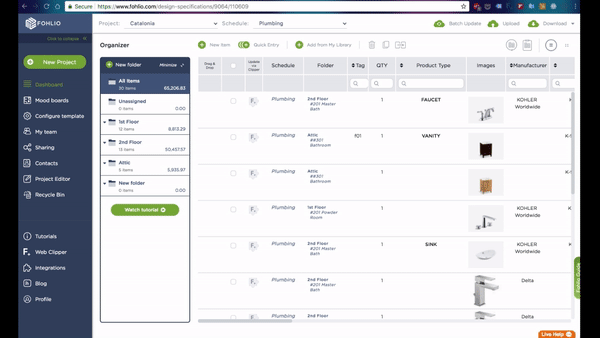

Manage FF&E specification, procurement, and product data at scale. Fohlio helps you take on bigger projects with confidence and grow your firm. Sign up to explore these features today.
Which spec writing software are you using for materials and FF&E specification? Does it matter?
There was a time when being the big fish in the design and architecture pond meant security. You’re not exactly lax — but who else has access to global projects and best-in-class technology?
These days, it’s everyone.
Learn more: Standardize Franchise Specification and Procurement Efficiently
A mid-size firm — heck, even a small one — can work anywhere in the world, thanks to technology getting better and cheaper all the time.
So then, you’ll have to wonder why the process of FF&E specification is so woefully outdated. And if that’s the case, then your firm is certainly not figuring out how to create value with the use of buildings’ lifecycle data.
Learn more: What is FF&E: The Ultimate Guide to Specification, Procurement, and More
Design and Construction Teams are Already Antagonistic Towards Each Other — Excel Isn’t Going to Help Them Collaborate (and Deliver) Better
Architects are not incentivized to make contractors’ work easier, and vice versa. “The architect is getting paid by an owner to create what’s called design intent. And when they’re done, their contract is over. All they’re trying to do is cover their own butt to make sure that during construction, the architects aren’t gonna get slammed,” says David Fouche, one of Fohlio’s product and marketing advisers.
Well, so what, right? That’s the way it’s always been, and we’ve always managed to get by. But what if it could be better? What if project owners actually got what they wanted? When we specify an avant-garde black toilet from Paris and the contractor installs a white one from Home Depot, wouldn’t it be nice if we immediately knew it was because the owner actually made the decision (instead of accusing the contractor of pulling a bait-and-switch)?
Read: 6 Tips to Make Your FF&E Specification Process Much Faster
If you use Excel sheets to manage products, you have documentation. But if you use a digital materials database to create spec sheets, you can have history and context.
Contractors can suggest alternative products and architects can approve them — all without having to switch between email and Excel.

Procurement is Always Going to Be Difficult and Expensive
Doing anything in Excel that isn’t accounting or maths is always going to have a ceiling. You can calculate costs, sure. But the actual FF&E ordering and tracking will require email, at least.
But let’s say you have a dedicated procurement software. That helps the procurement process itself, but your team still has to manually copy and paste products from spec sheets into the purchasing software. It’s not just slow and repetitive, it’s also prone to human error.
Excel won’t help you automate that part of the procurement process and free up hours that’s otherwise used in manual work and corrections. And that’s costing your firm.
Additionally, spreadsheets won’t turn your purchase orders into powerful tools that help you keep track of shipments and create financial forecasts.
It’s Time
Why does the start of a new project still send everyone scrambling to ask a teammate, “Do you still have that finish schedule from the Hong Kong project?”
You already know which materials you want to use — and even which suppliers to get them from — but why does it still take such a long time to put everything together?
Any client can get find any architecture firm anywhere in the world — but why can’t you find that specific flooring you need for your healthcare project?
Read: Your Design Firm Needs a Digital Materials Library. Here are 9 Reasons Why
Excel is Not a Specification Software
If you only work on one project a year, everything is local, and it’s not too complex, then there’s no pressing need to keep everything else simple.
But if you’re a multinational firm, working on a global scale, and having to deal with lots of nuances and complexities — and all while having to keep to design guidelines, a budget, and a schedule — then you need a dedicated spec writing software.
You need a tool that:
- Makes FF&E specification at scale fast and efficient
- Allows you to quickly re-specify trusted products approved by brands
- Helps you find the right product, according to health or government requirements, in seconds
- Keeps preferred collections of finishes and fixtures at your designers’ fingertips for better cost management
- Lets you build product and finish catalogues that help upsell and price out construction costs efficiently
- Keeps all your products in one place, regardless of category or division
- Makes it easy to value engineer products
- Can help you prove to clients that you’re reducing their costs
- Gives you quick and easy access to your firm’s collective knowledge
- Lets you collaborate easily and securely with all stakeholders
- Grows with your firm
Read: 8 Elements of an Indispensable Digital Materials Library
At Fohlio, we’re seeing the materials and FF&E specification process become more and more automated each day. Libraries and catalogues that used to be physical are becoming digitized, manufacturers are focusing on online sales, and major firms are investing heavily in their own internal software solutions so that they can stay lean and keep competition out of their space.
And maybe even enter your space.
In a customer-centric industry, having the right tools means everything. Are you still using hand drawings? Or are Revit, ArchiCAD, AutoCAD, Rhino, SketchUp, and the rest a must?
If that’s the case, then why should your FF&E specification process be any different?
The truth is that falling behind in a customer-centric world can escalate fast.
While you’re stuck using Excel or some thrown-together spreadsheet for FF&E specification, your competitors are building systems that capture and manage the information they need. These lines of communication are making it easier to translate design ideas to contractors, and clients. And it’s making relationships with vendors and collaborators more seamless than ever.

If your team is still wrestling with miscommunications internally and externally, you’re falling behind the competition. Your old school methods might feel familiar, but they’re holding you back. You might be in the land of Blackberries while everyone is sporting an iPhone.
Read: 3 Cost-Saving Reasons Your Hospitality Design and Procurement Teams Should Collaborate Better
At Fohlio, we make it our job to know what the best teams in the interior design, architecture, design build, remodeling and development space are doing.
The best designers see themselves as leaders, so we wanted to create a tool that would empower them and free them to focus on their high-level vision.
Because we know when you can share your vision without being tied up in little things, you can bring everyone together, and truly build something impressive.
Specify, procure, and manage product data at scale. Take on bigger projects with confidence and grow your firm with Fohlio. Schedule a demo or book a consultation with one of our account managers to explore these features today.
Expore Fohlio
Learn how to:
- Save days of work with faster specification
- Create firm-wide design standards
- Automate and centralize procurement
- Keep your whole team on the same Page
- Manage product data
- Track budget against cost in real time.
- Prepare for asset valuation
Published Jul 23, 2019

